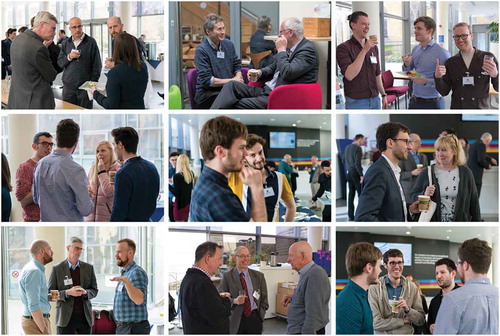The 35th annual meeting of the British Liquid Crystal Society (BLCS) took place at the University of Leeds (, top) from Monday 15th April to Wednesday 17th April 2019. The conference was organised by Dr Mamatha Nagaraj and Professor Cliff Jones (, bottom) from the Leeds Soft Matter Physics group, who welcomed nearly one hundred attendees from countries across the Globe, including USA, India, Pakistan, China, Czech Republic and Germany.
Figure 1. The 2019 BLCS meeting was held at the University of Leeds Business School (top) from 15th–17th April 2019 and was organised by Cliff Jones and Mamatha Nagaraj (bottom).

This year’s BLCS conference was unique as a special Symposium on lyotropic liquid crystals (L3C) was held prior to the start of the conference. The Symposium was organised by Mariam Hussain, a final year PhD student from the School of Chemical Engineering at the University of Leeds. Mariam’s goal was to attract a broader range of attendees to the BLCS conference, especially those working in the field of lyotropic liquid crystals. In addition, attendees of the Symposium would gain a detailed understanding of lyotropic liquid crystals, as a greater emphasis is often placed on thermotropic liquid crystal research. In this respect, the Symposium was a success, since it encouraged interactions between those working in thermotropics and lyotropics, and was evident from both the high attendance and the number of lyotropic-based presentations at the main conference. The Symposium featured a series of lectures given by leading researchers in the field of lyotropics. Professor Gordon Tiddy from the University of Manchester opened the Symposium with a lecture that introduced the fundamentals of lyotropic liquid crystals and the self-assembling supramolecular structures they form, placing an emphasis on surfactants. Further, Dr Arwen Tyler (University of Leeds), Professor John Seddon (Imperial College London) and Professor Mark Wilson (Durham University) presented the fascinating science behind the phases, theoretical simulations and applications of lyotropic liquid crystals. Finally, Dr John Lydon from the University of Leeds closed the Symposium with a presentation on tactoids and their occurrence in colloidal lyotropic sols and, in particular, their relationship to the shape of red blood corpuscles. The Symposium was followed by lunch, whereby further discussions and networking between participants took place ().
The BLCS conference began on Monday afternoon after the L3C Symposium, whereby all attendees were warmly welcomed by Cliff and Mamatha. Cliff pointed out that the conference was exactly 51 years to the day since Leeds hosted a special meeting of the Faraday Society on Liquid Crystals, where (later, Sir) Charles Frank was to present his ground-breaking paper on elasticity and defects in liquid crystals. Research topics being presented at the current conference were across all disciplines: from colloids, lyotropics and materials, to theory and devices. The oral presentation sessions were opened with the plenary lecture by Professor Ivan Smalyukh from the University of Colorado Boulder, USA, titled ‘Nematic colloidal crystals and micro-motors powered by light’.
Monday’s session on the theme of ‘Novel Compounds’ featured a series of engaging talks focussed on the twist-bend nematic phase. The first was by Professor Corrie Imrie from the University of Aberdeen, Winner of the 2019 Grey Medal. The Grey Medal is awarded for outstanding contributions to research in liquid crystal science and technology, and was first awarded in 1996 to George Grey’s former PhD student Professor John Goodby. Corrie’s presentation ‘Liquid crystal dimers: from the intercalated smectic phases to the twist-bend nematic and smectic phases’ was highly informative and explained the background of these phases in detail. Richard Mandle from the University of York also gave an invited talk on the discovery of materials exhibiting a splay nematic phase.
The Tuesday sessions began with two special talks. The first was by Professor Dirk Broer from Eindhoven University of Technology, Netherlands, on the topic of reactive mesogens and their applications and further developments. Dirk was awarded the 2018 Grey Medal at this year’s conference, as he was unable to attend last year’s conference at the University of Manchester. Following Dirk’s talk, postdoctoral researcher Dr Markus Wahle (, left) from Cliff Jones’s group at the University of Leeds, and Winner of the 2019 BLCS Young Scientist Award, presented his research on optical devices based on liquid crystals.
Figure 3. Left: Markus Wahle, recipient of the 2019 young scientist award. Middle & right: various hand gestures taking place during Tuesday’s post-talk question sessions.
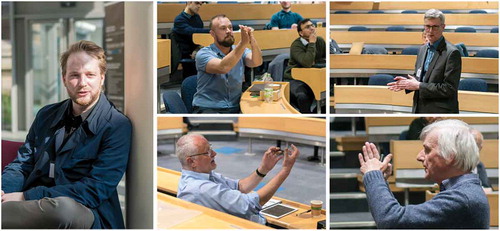
The hour-long poster sessions () were held on the evenings of Monday and Tuesday, prior to dinner. The sessions featured 28 posters, including those presented by several undergraduate students – Nick Garner from Cliff Jones’s group, Clare Verduyn from Helen Gleeson’s group and Bianca Marcucci from Ingo Dierking’s group. This continued a long tradition at BLCS meetings, which gave students at the start of their scientific careers exposure to presenting in an academic environment. Professor Linda Hirst (, top left and ) from the University of California Merced, USA presented a poster titled ‘Chaotic dynamics in a 2D active nematic’. Linda is the recipient of the 2019 Cyril Hilsum Medal, an award in honour of Cyril Hilsum, former Head of the Malvern Displays Group, and his contributions to the development of liquid crystal materials and displays. It has been awarded almost every year since 2006 for overall notable contributions to research in liquid crystal science and technology by world-leading technologists in their mid-career.
Figure 4. Curious conference participants eager to learn about the interesting research taking place within the liquid crystals community during the poster sessions.
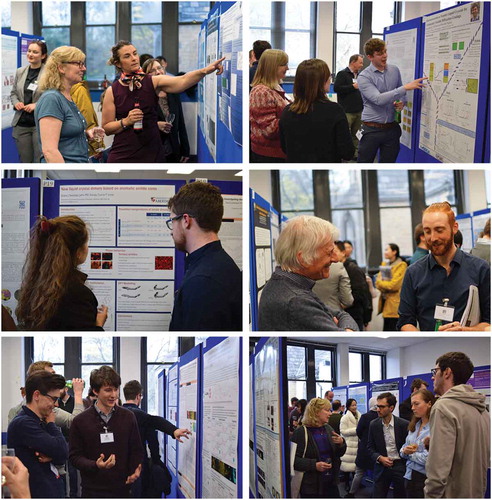
The Conference Dinner was held on Tuesday evening at the University House on the University of Leeds campus. During the dinner, BLCS President Professor Georg Mehl presented Linda Hirst (, left) with the 2019 Cyril Hilsum Medal. Linda spoke of her great honour to have received this recognition for her work. Linda gave a speech about her time as a PhD student at the University of Manchester under the supervision of Professor Helen Gleeson and how her career as a scientist had developed since moving to the USA to become a postdoctoral researcher. Georg also presented Dirk Broer (, middle) and Corrie Imrie (, right) with the respective 2018 and 2019 Grey Medals. Corrie’s extremely entertaining speech featured references from the Game of Thrones TV series. As the first episode of the ultimate season of the series had just been released during the conference, Corrie was struggling to decide which character best matches Cliff. Contemplating whether the character was The Hound or The Mountain, it suddenly dawned on him moments before dinner, as he was entering the room and Cliff was stood holding open the door for him. Of course, no spoilers are published here.
Figure 5. The conference dinner held on the evening of Tuesday 16th April 2019. Left: Linda Hirst, recipient of the 2019 Cyril Hilsum Medal. Middle: Dirk Broer receiving the 2018 Grey Medal. Right: Corrie Imrie, recipient of the 2019 Grey Medal.
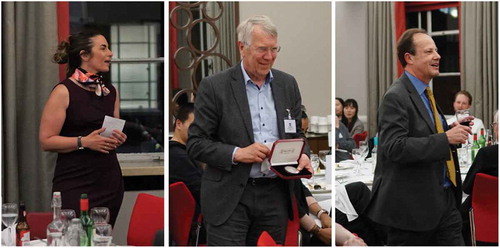
The final day’s topics were devoted to materials physics and chemistry. They began with the 2019 Sturgeon Lecture presented by Professor R. Pratibha (, left), titled ‘Unusual forms of liquid crystal-fibre self-assembly’. Pratibha works as an Emeritus scientist at the Raman Research Institute in Bangalore, India and she is the first female to be awarded the Sturgeon Lectureship. The Sturgeon Lectureship is awarded annually in memory of Ben Sturgeon, who worked alongside George Grey and Cyril Hilsum and was responsible for commercialising the first liquid crystal materials to be used in displays.
The conference featured a range of superbly presented student talks. A special mention goes to Christopher Lakey, a PhD student from the Theoretical Physics group at the University of Warwick, for his presentation titled ‘Swimmers in Smectics’, which described self-propelling colloidal particles in smectic liquid crystals. Even though Christopher’s work involves complex mathematics, he was enthusiastic and managed to convey his research to the audience clearly, so that even those from a non-mathematics background could comprehend without any difficulty. A personal favourite was Mariam Hussain’s talk from the ‘Surfactants and Lyotropics’ session, titled ‘The aqueous phase behaviour of linear alkylbenzene sulphonate/polycarboxylate polymer systems’. Mariam showed admirable passion for her work which involves understanding the properties of detergents with the aim of formulating them with improved efficiency. Aaron Pim, a second year PhD student from the University of Bath, must also be mentioned for dramatically presenting his maths-based research in the ‘Device Theory’ session, titled ‘Asymptotics of nematic liquid crystals vector structure in rectangular wells with circular exclusions’.
The prize for the best student oral presentation was split between Rebecca Walker (, middle) from Corrie Imrie’s group, who talked about heliconical nematic and smectic phases exhibited by non-symmetric liquid crystalline dimers, and Nikita Solodkov from Cliff Jones’s group, who presented his work on the self-assembly of fractal liquid crystal colloids. The prize for the best poster presentation was awarded to first year PhD student Tom Raistrick (, right) from Helen Gleeson’s group, with his poster titled ‘Understanding liquid crystals that stretch’. In addition, there was a special mention to Xiaoxue Du from the University of Leeds, whose poster presented work on cholesteric liquid crystal droplets towards applications in novel biological sensors.
Figure 6. Left: Professor R. Pratibha joyfully answering questions during the 2019 Sturgeon Lecture. Middle: Rebecca Walker, joint recipient of the prize for the best student oral presentation. Right: Tom Raistrick, recipient of the prize for the best student poster presentation.

As is customary for the annual BLCS meeting, John Lydon closed the conference presentations, this time with his story about the early life and developing career of a Mathematician he referred to as ‘Willy’. At the end, he revealed that the Mathematician was Professor William Henry Bragg, who occupied the Cavendish Chair of Physics at the University of Leeds from 1909 to 1915. Following the presentation, John showed us an induction coil () that belonged to W. H. Bragg and was used for the pioneering work in the determination of molecular structure by X-ray diffraction. Many years ago, this induction coil was almost discarded, however, John had rescued it during his time as a young lecturer at Leeds. It was recently restored at the University of Leeds Physics workshop by Brian Chesworth and Keith Dredge. John presented Bragg’s induction coil to Helen Gleeson, who has been occupying the role of the Cavendish Chair of Physics at the University of Leeds since 2015.
Figure 7. The induction coil that belonged to Professor William Henry Bragg during his time as the Cavendish Professor of Physics at the University of Leeds was presented to the current occupier of this position, Professor Helen Gleeson, at the end of the 2019 BLCS conference.
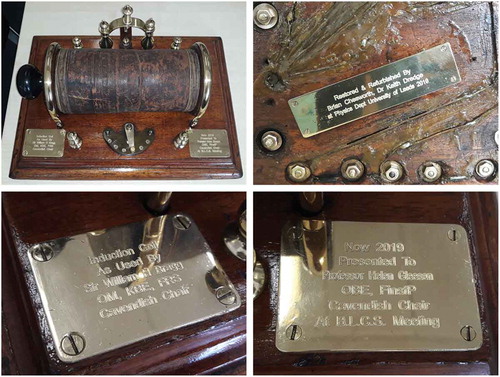
The conference ended with closing remarks by Cliff and Mamatha, followed by lunch and goodbyes. Next year’s BLCS conference will be held at the University of Aberdeen in April 2020, prior to Easter.
Special thanks go to Nikita V. Solodkov for providing photographs. This report is dedicated to Brian Chesworth, who sadly passed away shortly after the conference.

